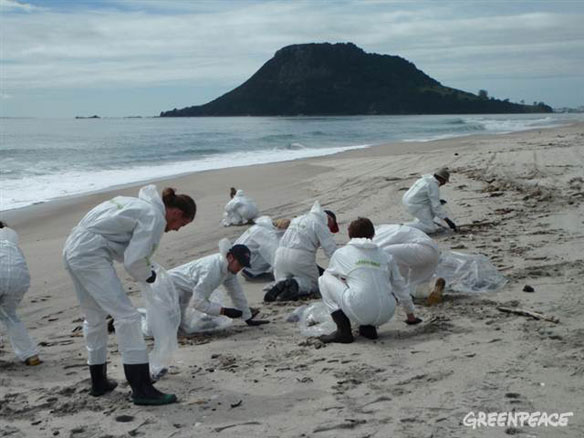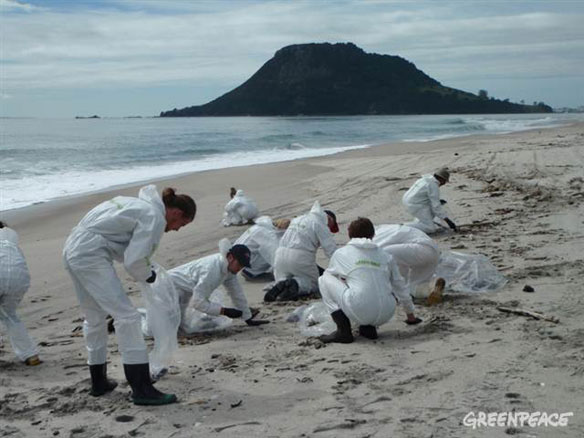
By Steve Abel, Greenpeace International / New Zealand,
Salvers of the Rena chillingly describe her as a “dying ship”. Bad weather will hit the Bay of Plenty again tonight (October 18th) and could cause the final break up of the vessel.
Pumping of oil finally began again last night but a fractional 90 tonnes was removed of the over 1,000 tonnes that it’s hoped remain in the fuel holds of the Rena. So far at least 350 tonnes of the ships total original load of 1,700 tonnes of fuel oil has spilled into the precious Bay of Plenty and tarred her beaches, wetlands, rocky shores and multifarious species.
Now the Rena is set to join the wildlife fatalities her grounding has caused. But if she breaks and the remainder of that oil is released we will see four times the volume of oil already spilled entering the environment.. It must be remembered that what we can get to and remove, is only a part of what permeates the environment.
What has already being painstakingly picked and shovelled from the beaches at Papamoa, Maunganui and Matakana is not the whole story rocky shores and wetlands are nearly impossible to clean of oil.
Around 5000 volunteers have reportedly been mobilised in the effort. It was heartening to witness this first hand. Our team has been on Matakana Island the past three days helping the locals clean the oil from the island’s shores. There’s less oil now but there is a sense that it’s also getting harder to find as time goes on. But the volunteer mobilisation is a consequence of outraged locals demanding to be utilised in cleaning oil off their beloved beaches. It was never part of the original oil response plan. At a public meeting in Papamoa, two nights ago, representatives of Maritime New Zealand acknowledged they acted too slowly in utilising this people power.
But consider that MNZ claim to have capacity to deal with 3,500 tonnes of oil with a mobilisable oil response personnel of 400 people.
We have seen here the effects in the Bay of Plenty of only one tenth of that quantity of oil (350 tonnes) and it has taken 5000 volunteers alongside military, local council and Maritine NZ Staff to only partially deal with it. There is still oil drifting off towards Whakatane and Te Kaha and it has hammered Motiti and hit Whale and White Islands with, as far as we know, little on the ground response as yet. The unseen impacts on bird and seal carcasses carried out to sea, and shellfish beds contaminated for months to come are unfixable.
One way to get a grasp of the scale of this spill, described as small by worst case scenario standards, is to use relative measurements more familiar to us.
Let’s say we were to visualise that 350 tonnes that has spilled from Rena thus far, as one teaspoonful of oil. Then the entire oil cargo of Rena is equivalent to 5 teaspoons (1,700 tonnes or two million litres). Maritime NZ purportedly have capacity to deal with 3,500 tonnes or 10 teaspoons.
The infamous Exxon Valdez oil tanker spilled around 100 million litres of oil in 1989 which would be the equivalent of 250 teaspoons.
And finally the US Gulf of Mexico deep sea oil disaster last year spilled 780 million litres. That would comparatively fill an entire 10 litre bucket with oil.
There, over 6000 ships were mobilised as well as tens of thousands of people.
Over 1000 tonnes (or about four teaspoons) hangs in the balance on the fracturing Rena here in the Bay of Plenty. But out at the tip of the East Cape much more vast quantities potentially exist deep below the ocean’s surface. If, as the government plans, these deep sea reserves are tapped they inevitably bring with them the risk that quantities of oil as huge as those that flooded the Gulf of Mexico last year might inundate our own precious Bay of Plenty on a scale many hundreds of times worse than what we see now.
Oil Reach Picturesque Beaches, New Zealand Herald
Oil and containers that have tumbled from the stricken cargo ship Rena have begun washing up more than 130 kilometres away on picturesque East Cape beaches. meanwhile, the lessees of the Rena have pledged a $1 million “donation” to aid the clean-up – an action that has left some questioning the company’s remorse.
Oil Spill Disaster In New Zealand: Worst In Decades
The Rena oil spill has brought home to people that New Zealand’s oceans and coastlines aren’t worth gambling for oil, Greenpeace
While oil is being cleaned up on the Bay of Plenty coast, US oil giant Anadarko has a deep sea exploratory vessel are off the Raglan coast threatening exactly the same sort of disaster in the future from deep sea oil drilling. As the shipwrecked Rena lies in the Bay of Plenty and its spilled oil washes ashore, Elvis Heremia Teddy is to appear in a Tauranga court today because he took a stand to protect his home coastline from oil spills.









